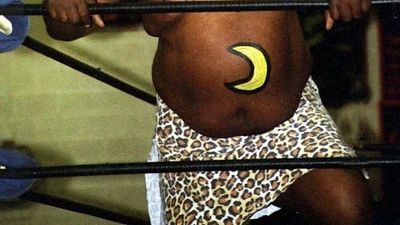James "Kamala" Harris Was an Example of How Black Wrestlers Overcame Racist Gimmicks
The late, great James Harris, who wrestled as “The Ugandan Giant” Kamala for almost 30 years, was a pioneering example of how Black athletes found success and career longevity in spite of portraying racists stereotypes that were forced upon them.
The story of Black professional wrestlers throughout the 19th and 20th centuries is a familiar one. Talented Black athletes had to overcome racial barriers and discriminatory practices. However, it can be argued that pro wrestling was — and still is, to an extent — rife with more egregious cases of racial exploitation and discrimination through stereotypical gimmicks, unequal pay and advancement opportunities, and, in some instances, sexual exploitation. The late, great James Harris, who wrestled as “The Ugandan Giant” Kamala for almost 30 years was a pioneering example of how Black athletes found success and career longevity in spite of portraying racists stereotypes that were forced upon them.
World Wrestling Entertainment (WWE) announced that Mississippi native James "Kamala" Harris, the Mississippi native died this past Sunday, August 9 after suffering from a cardiac arrest from complications caused by COVID-19. Harris, who was 70, also suffered from a long battle with diabetes and high blood pressure since 1992 and had his left leg amputated in 2011. He is survived by his wife Melissa Guzman.
Harris’s story is similar to a lot of Black wrestlers of his era such as Thunderbolt Patterson, the first Black World Heavyweight Champion Ron Simmons, and the late Sylvester Ritter, aka The Junkyard Dog. Harris came to age in a poor and working-class environment in Mississippi and became a pro wrestler in order to earn a significantly substantial living that was not immediately available for Black people in the '60s and the '70s. While some wrestlers were the typical bruising tough guys and charismatic slick talkers akin to their white counterparts, others were given gimmicks based on racial stereotypes.
While these types of gimmicks weren’t exclusive to Black wrestlers — pro wrestling is generally built around parodies and stereotypes of real-world figures — Black wrestlers often had the most overt gimmicks that played into the fears and biases of white fans. Enter Harris's “Kamala” character, a Ugandan headhunter created by wrestling pioneer Jerry “The King” Lawler, The Great Mephisto, and Jeff Jarrett, inspired by racist stereotypes of African tribes from a Frank Fazella painting. While Black wrestlers who portrayed these types of gimmicks often didn’t have a choice, as these types of characters were proven to be the most lucrative, they did, as the old saying in wrestling goes, “turn chicken shit into chicken salad.”
Behind such a foul gimmick that was not viewed as critically as it is today, was one of the talented Black wrestlers of his day. Harris was fearsome at 6’7, 380 pounds, but he was more agile and athletic than many of his white counterparts. He worked with the late Andre the Giant and Hulk Hogan at the height of their careers. And despite him not being able to speak, he exuded charisma and a persona that scared children and adults alike and he became a top billing, main event player. However, because Black wrestlers, even in WWE, weren’t always considered as “championship material”, he was never able to maximize his career to become the true superstar he never had the chance to become as he would never. And after a fateful meeting with WWE, then WWF, CEO Vince McMahon over his low pay in 1984, he would leave the company and perform independently across the world, including on-and-off stints with WWE.
“I wish things had worked out better for me. I believe the reason why I got done is because I’m a poor boy from down south Mississippi," Harris said in a 2015 Bleacher Report mini-doc. "If I had been a better talker, knew how to negotiate, that probably would have helped me."
Harris would never earn any championship belts from the promotion. To this day, despite being such a lucrative and memorable character, he has still not been inducted to neither the WWE Hall of Fame nor the Professional Wrestling Hall of Fame. And it should serve as a black eye among many others to the industry because, as terribly offensive as the Kamala character was, his success paved the way for many other successful wrestlers of color such as the late Edward “Umaga” Fatu, Martin “The Boogeyman” Wright, and many other legendary giants of color like Mark Henry, Rikishi, Viscera, Charles “The Godfather” Wright, The Great Khali, and many others.
Harris portraying as a racially insensitive stereotype of Africans is not a mark against a talented athlete who made the best out of what he was given, but rather an indictment of a complicated institution that profited from the fears and bigotry of the most racist of Americans. It was true with characters like The Junkyard Dog and the infamous New Jack and while significantly more nuanced, it is still true with the first iteration of WWE’s longest-running and successful stable, The New Day.
The life and career of James “Kamala” Harris deserves to be remembered as a testament of how Black wrestlers and wrestlers of color had to overcome the most racist of gimmicks. Even though he was designed to fail, he still became some of the most well known professional wrestlers of his time. And despite years of suffering from health issues and the shameful treatment from the wrestling business, Harris never wanted pity.
“I don’t want people to feel sorry for me because I’m still Kamala and I’ll always be Kamala.”
__
